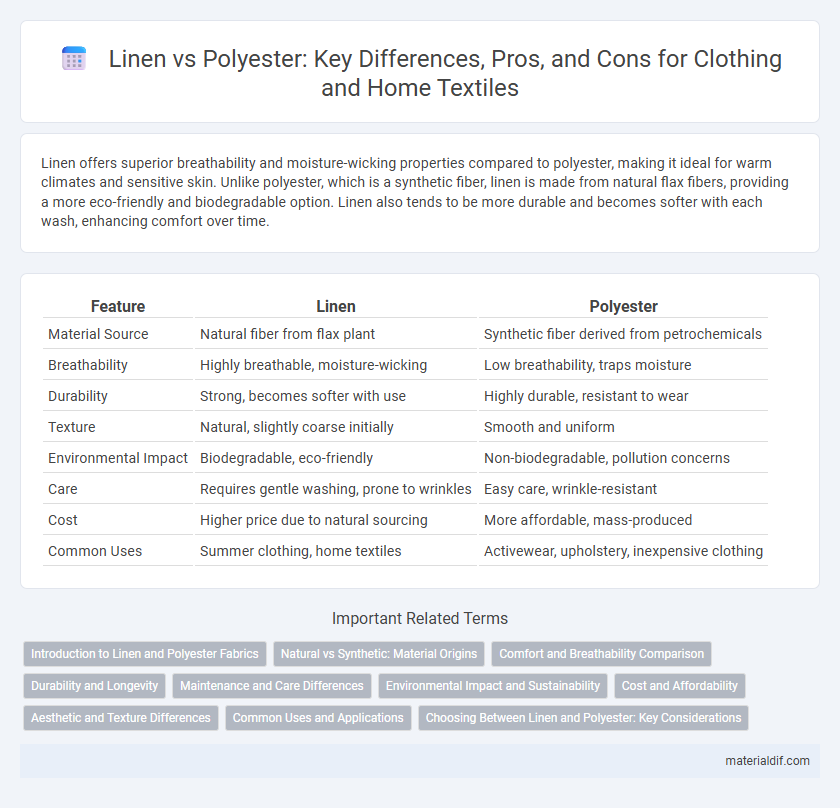Linen offers superior breathability and moisture-wicking properties compared to polyester, making it ideal for warm climates and sensitive skin. Unlike polyester, which is a synthetic fiber, linen is made from natural flax fibers, providing a more eco-friendly and biodegradable option. Linen also tends to be more durable and becomes softer with each wash, enhancing comfort over time.
Table of Comparison
| Feature | Linen | Polyester |
|---|---|---|
| Material Source | Natural fiber from flax plant | Synthetic fiber derived from petrochemicals |
| Breathability | Highly breathable, moisture-wicking | Low breathability, traps moisture |
| Durability | Strong, becomes softer with use | Highly durable, resistant to wear |
| Texture | Natural, slightly coarse initially | Smooth and uniform |
| Environmental Impact | Biodegradable, eco-friendly | Non-biodegradable, pollution concerns |
| Care | Requires gentle washing, prone to wrinkles | Easy care, wrinkle-resistant |
| Cost | Higher price due to natural sourcing | More affordable, mass-produced |
| Common Uses | Summer clothing, home textiles | Activewear, upholstery, inexpensive clothing |
Introduction to Linen and Polyester Fabrics
Linen, derived from the flax plant, is a natural fiber known for its breathability, moisture-wicking properties, and durability, making it ideal for warm climates and eco-friendly textiles. Polyester, a synthetic fiber created from petroleum-based chemicals, offers high strength, wrinkle resistance, and quick-drying capabilities but lacks the natural breathability of linen. Understanding the fiber origins and physical characteristics of linen and polyester helps in selecting the appropriate fabric for comfort, sustainability, and performance needs.
Natural vs Synthetic: Material Origins
Linen, derived from the flax plant, is a natural fiber known for its breathability, durability, and eco-friendly cultivation, making it a sustainable choice in textiles. Polyester, a synthetic fiber created from petroleum-based chemicals, offers strong resistance to wrinkles and stretching but lacks the biodegradability and moisture-wicking properties of natural fibers. The origin of linen as a renewable plant-based material contrasts sharply with polyester's reliance on fossil fuels and energy-intensive manufacturing processes.
Comfort and Breathability Comparison
Linen offers superior breathability compared to polyester due to its natural fiber structure, allowing better air circulation and moisture-wicking properties that keep the skin cool and dry. Polyester, being synthetic, tends to trap heat and moisture, often causing discomfort during prolonged wear, especially in warm climates. The inherent softness and lightweight nature of linen make it a preferred choice for comfort in hot and humid conditions over polyester fabrics.
Durability and Longevity
Linen outperforms polyester in durability due to its strong natural fibers that become softer and stronger with each wash, resisting pilling and wear over time. While polyester is resistant to stretching and shrinking, it tends to degrade faster under UV exposure and repeated washing. High-quality linen garments often last longer than polyester counterparts, making them a sustainable and resilient choice.
Maintenance and Care Differences
Linen requires gentle washing with mild detergents and benefits from air drying to maintain its breathability and texture, while polyester is more durable, often machine washable, and resistant to wrinkles and shrinking. Linen fibers absorb moisture easily, which necessitates careful drying to prevent mildew, whereas polyester's synthetic nature allows it to dry quickly and resist mold growth. Proper care of linen preserves its natural luster and softness, contrasting with polyester's low-maintenance, synthetic resilience and longevity.
Environmental Impact and Sustainability
Linen, derived from the flax plant, is biodegradable and requires significantly less water and pesticides compared to polyester, which is a petroleum-based synthetic fiber with a high carbon footprint. Polyester production relies heavily on non-renewable resources and contributes to microplastic pollution in oceans, while linen's natural fibers decompose without releasing harmful substances. Choosing linen supports sustainability through renewable sourcing and reduced environmental impact over the garment lifecycle.
Cost and Affordability
Linen typically costs more than polyester due to its natural fibers and labor-intensive production, making it a premium fabric choice. Polyester is widely available at a lower price point, offering affordability and durability for budget-conscious consumers. Consumers often choose polyester for cost-effective everyday wear, while linen is preferred for its breathability and luxury despite higher expenses.
Aesthetic and Texture Differences
Linen boasts a natural, matte finish with a slightly slubby texture that enhances its rustic and elegant aesthetic, while polyester typically has a smooth, shiny appearance that can look synthetic. The breathable, crisp feel of linen contrasts with the often slick, less absorbent texture of polyester, making linen preferred for its tactile comfort and organic charm. These differences in texture and visual appeal influence choices in fashion and home decor, where linen's authentic and textured look is favored over polyester's uniform surface.
Common Uses and Applications
Linen is commonly used in high-quality home textiles such as bed linens, tablecloths, and summer apparel due to its breathability and moisture-wicking properties. Polyester, favored for its durability and wrinkle resistance, is widely applied in activewear, upholstery, and budget-friendly clothing. Both fibers serve distinct purposes: linen excels in comfort and natural aesthetics, while polyester offers practical benefits for heavy use and easy care.
Choosing Between Linen and Polyester: Key Considerations
Linen, made from flax fibers, offers superior breathability, moisture-wicking properties, and environmental sustainability compared to polyester, a synthetic fabric derived from petroleum. Choosing between linen and polyester depends on factors such as comfort in hot climates, durability, wrinkle resistance, and ecological impact. Linen excels in natural fiber benefits and biodegradability, while polyester provides affordability, stain resistance, and easier maintenance.
Linen vs Polyester Infographic

 materialdif.com
materialdif.com